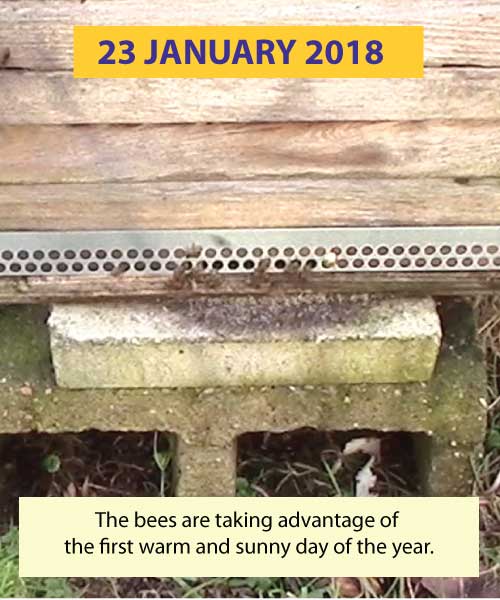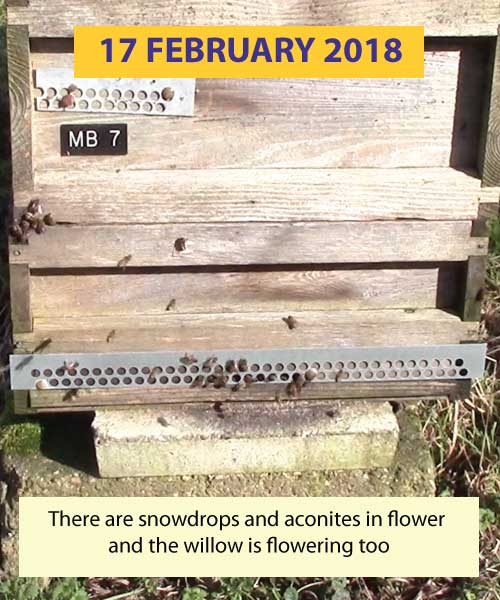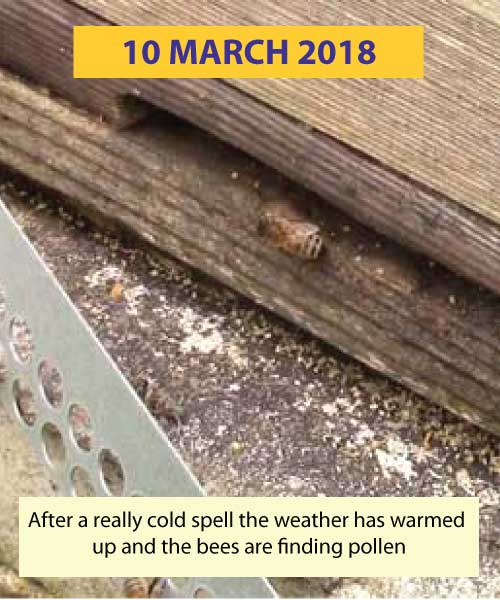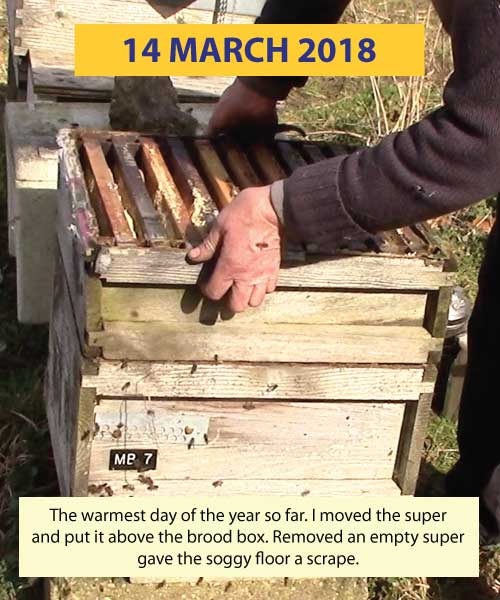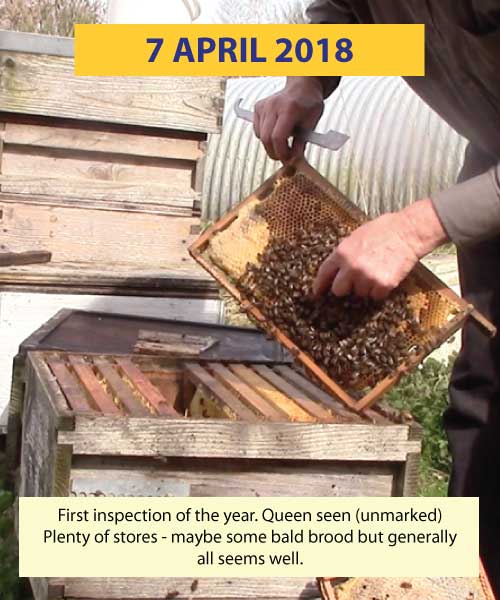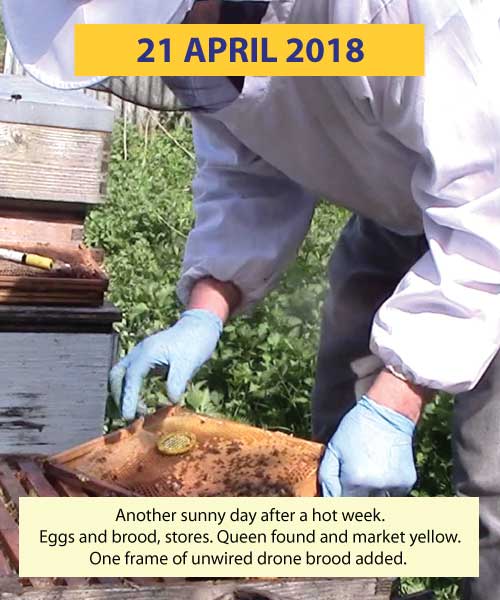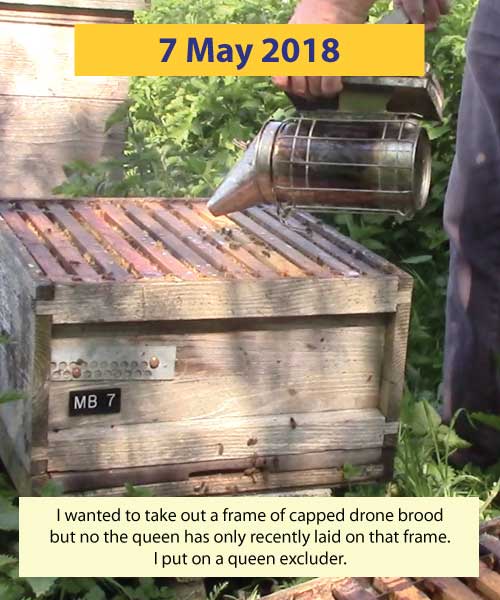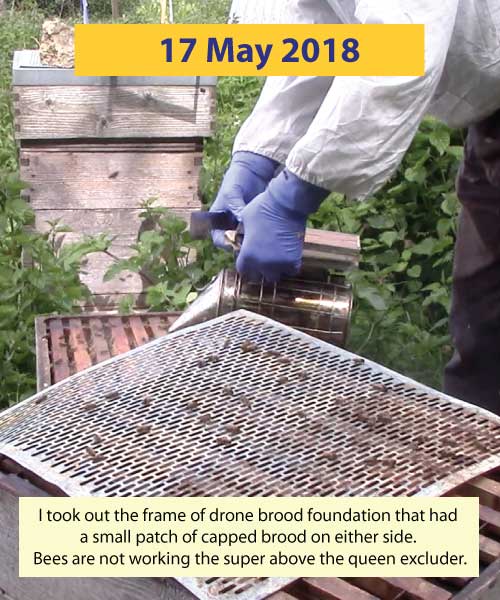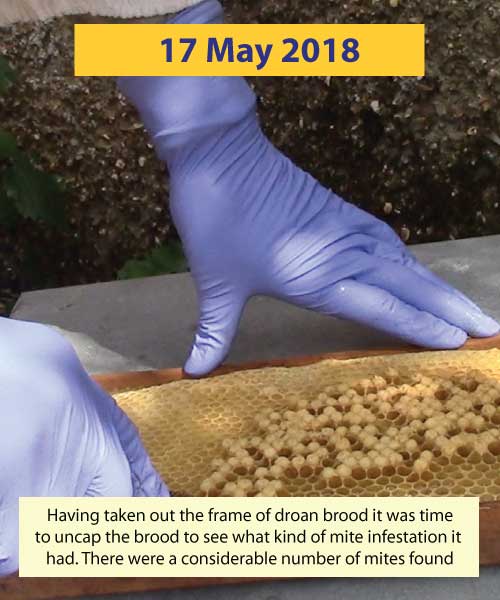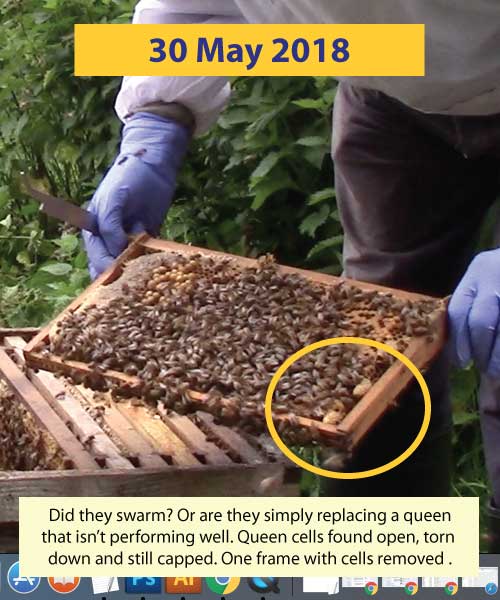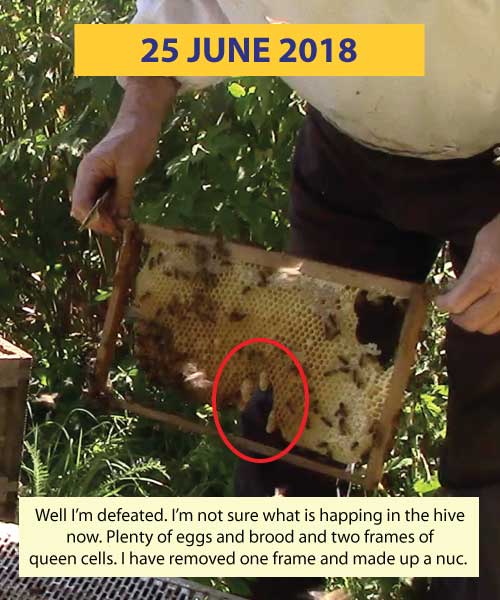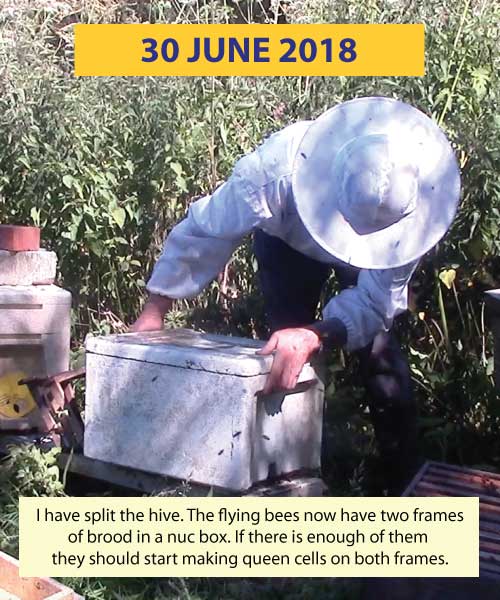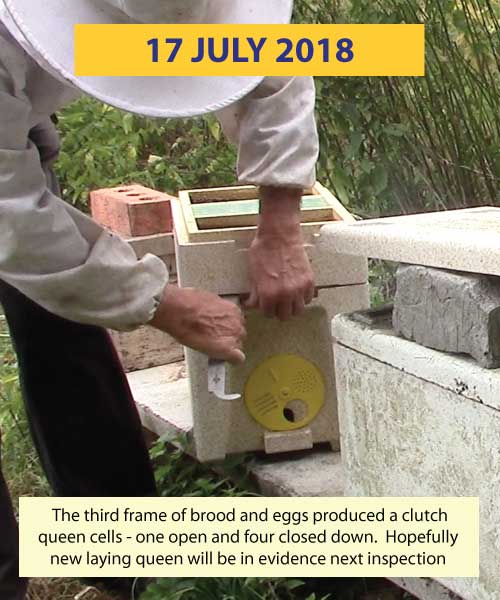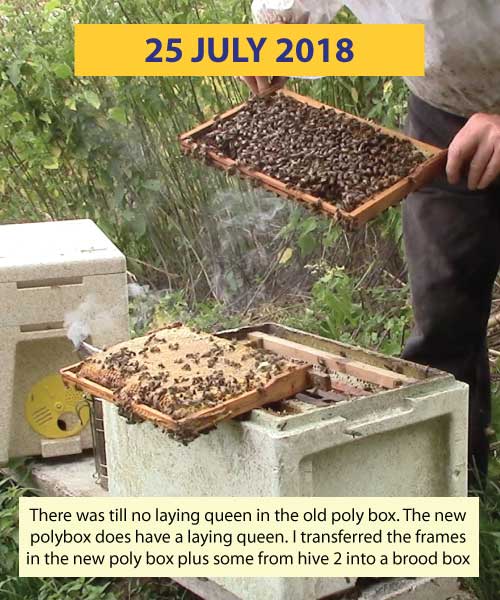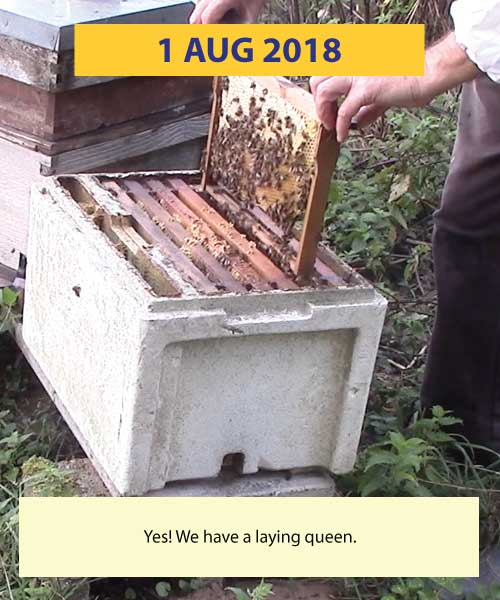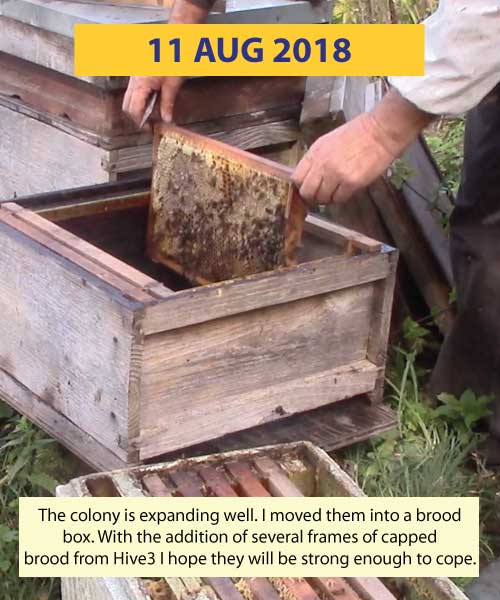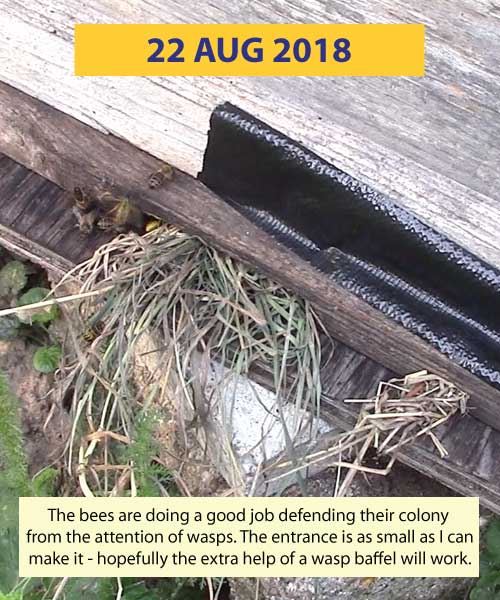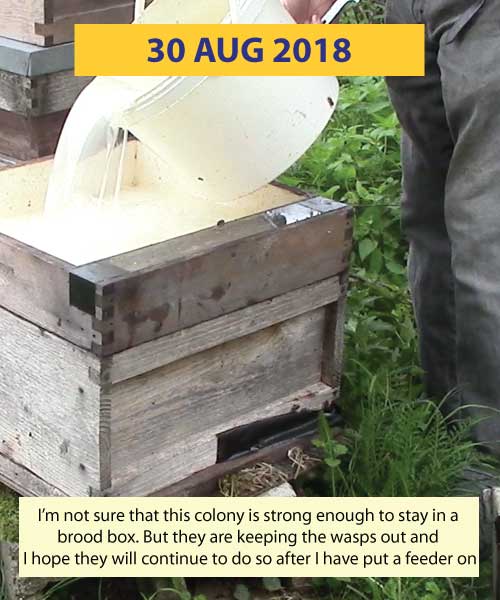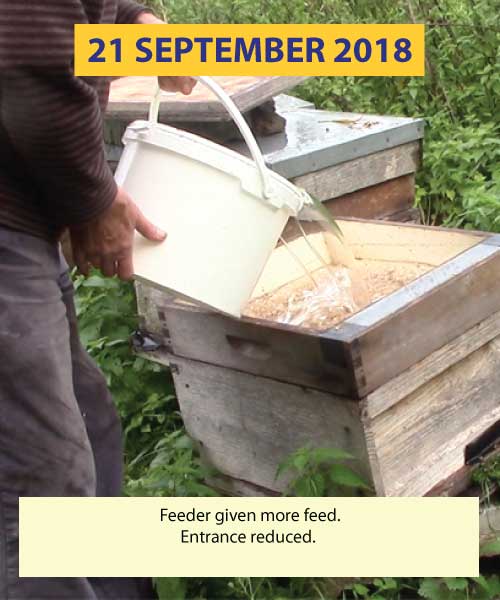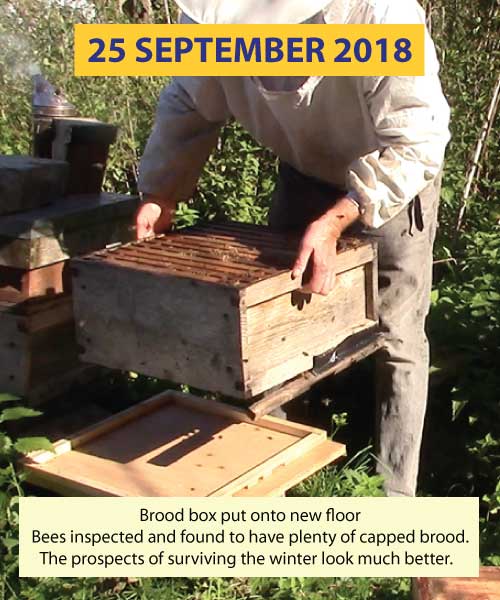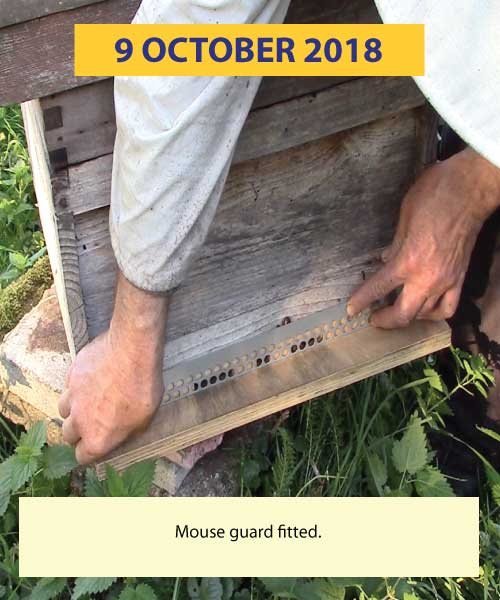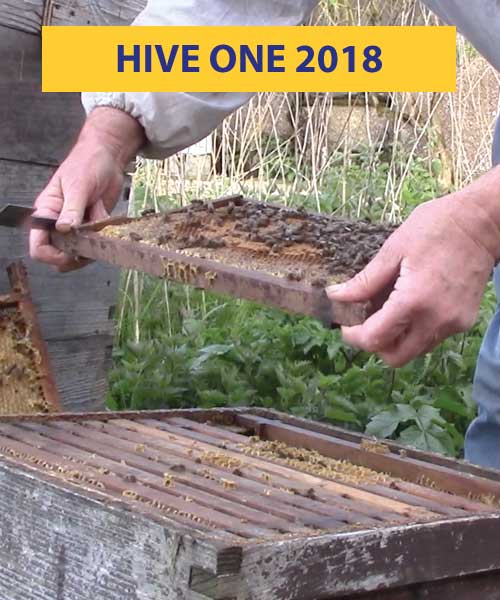
23rd January. First visit of the year. It was a warm day. briefly getting to 12 degrees centigrade and the bees were flying -![]() to see video
to see video
17th February. Bees flying taking pollen in - willow, snowdrops and aconites in flower - ![]() to see video
to see video
10th March. The weather has warmed up again and the bees are busy collecting pollen. Mousegard removed. - ![]() to see video
to see video
14th March. My car dashboard said 14 degrees - the warmest day of the year so far. This hive has a solid floor and solid floors can get damp and dirty over a winter so a quick scrape clean was required. I moved the super up from under the brood box and put it on top. -![]() to see video
to see video
7th April. A calm warm sunny day. Just right for a first inspection. Queen seen unmarked. -![]() to see video
to see video
21st April. We have a had week with some exceptionally (for the time of year) hot days in it. The heat has affected the spare frames of stores in the top brood box and for the first time the bees were up there when I opened the hive. Queen found and marked. One frame of unwired drone brood put in -![]() to see video
to see video
7th May. We have had some extremely hot weather for this time of the year and today was a very hot day too. I had intended to remove the frame of drone brood this visit but far from being capped it hadn't even been fully drawn out or laid in. On inspection the queen had just moved into the super to lay. I returned her to the brood box. Is this restriction of the queen a good thing? I'm not so sure - if she wants move up should she not be allowed to? The general brood pattern is not good - is this the effect of Varroa? Or are there other issues with the brood apart from Varroa? Chalk Brood? Or Sac Brood?![]() to see video
to see video
17th May. Ten days since my last visit and although there were patches of warm sunshine there was a constant cold wild blowing from the North so I didn't stay in the brood box for too long. I took out the frame of drone brood foundation that was far from fully laid and capped but did have a small amount of capped drone brood for me to test.![]() to see video
to see video
Drone brood test. There was little enough drone brood to uncap - but enough to find a considerable number of mites. I think that the mite load is too high now for the bees to be expected to make a reasonable honey crop this season. That is if the bees are left to their own devices. Now would be a good time to remove all of their brood again whilst they still have stores to use for making new wax ![]() to see video
to see video
30th May. There were no eggs but there were queen cells. One open, one torn down and a couple capped on the same frame. I took out the frame with the two queen cells on it and made up a nuc by adding two frames of brood from two of the other hives in the apiary. My question is 'did they swarm or were they just replacing a queen that wasn't performing well?'![]() to see video
to see video
25th June. The bees have got me and I no longer know what is going on in this hive. On inspection today I found two frames with queen cells, Some capped and some still in production, and many frames of eggs and brood, but no queen. And from the video you can see that I really did look for her. I ended the inspection by taking out one frame of stores and one frame of queen cells (to make up a nuc) and leaving one frame with queen cells in there. I will leave the colony now for four or five days before making another inspection and another search for the queen. ![]() to see video (A)
to see video (A)
and ![]() to see video (B)
to see video (B)
30th June. I have finally given up on these bees and introduced two frames of brood from a strong colony to the flying bees with the intention that they should make queen cells. Lets hope there are enough flying bees to get one started on each frame. ![]() to see video.
to see video.
17th July. I seem to be short of a video. The two frames that I added had (four days later) one queen cell on one frame in production and a capped scrubby little queen cell on the other frame. I took out the queen cell in production and made up a nuc with the flying bees of the hive(one) that I had moved four days earlier (the original hive one {it is still going strong after re-queening it'self but has been moved to another site}). I gave bees in the old nuc box (now hive one) a third frame of brood from a colony of darker bees. That frame of brood produced a clutch of queen cells one which was open and four that had been torn down. No eggs as yet. ![]() to see video.
to see video.
25th July.There were still no signs of a laying queen in the old poly box. The new poly box did have a laying queen and the bees were filling up the space. I took out the frames from the new poly box and put them into a brood box and added in some frames of brood and eggs from Hive2 ![]() to see video.
to see video.
1st August. Yes we do have a laying queen ![]() to see video.
to see video.
11th August. I moved the frames from nuc box into a brood box and added some frames of brood from Hive3 and put on a super ![]() to see video.
to see video.
At this point I have three new
colonies originating from Hive1 that I started the year with. It wasn't my intention to produce more colonies. As they had a new queen last year I was wanting to see how much honey Hive1 would make this year - as this is it's third year without chemical treatments. The bees however didn't like their queen and I was slow in recognising that fact. I did get with it in the end and I now I have four colonies instead of one. Two of the four are daughters from Hive1 (one in the the original Hive1 brood box) the other two are from other colonies. The second nuc is from one of my 'best strains' of bee. The bees now in Hive1 have a queen from a random colony that seemed to be doing well at the time I needed a frame of brood.
22nd August. As Hive1 has the youngest queen in it of all the hives in the apiary and is likely to be the smallest colony it seems to be the one the wasps are most interested in. The bees were doing a good job of defending it ![]() to see video. However, I thought a little help would not go amiss
to see video. However, I thought a little help would not go amiss ![]() to see video. And after some extra tape I think it was working and will help to keep out the pesky wasps
to see video. And after some extra tape I think it was working and will help to keep out the pesky wasps ![]() to see video.
to see video.
30th August. I'm not sure that this colony is strong enough (even after having been given extra brood) to manage to survive the winter in a brood box. They may be better off moved into a poly nuc box for the winter. However, the bees are managing to keep the wasps out so far. I have put a feeder on and hope that won't
upset the balance of power in the wasps favour. ![]() to see video.
to see video.
21st September. More food given .![]() to see video.
to see video.
25 th September. New floor. Enjoying a spell of warm weather the bees were flying and bringing in pollen. On inspection there was good amount of capped brood and the queen was laying well. Feeder topped up.
![]() to see video.
to see video.
9th October. A warm day for this time
of the year - mouse gard put on ![]() to see video.
to see video.
![]() to see video.
to see video.
Hive Details
- Brood box: - Standard National
- Queen - 2014 - replaced with daughter 2017. Daughter not liked by bees 2018. The queen now is from a darker strain
- Type of bees: - Norfolk Mongrels?
- Make honey? - Yes, but not the best honey makers by comparrison. We have yet to see
- Temperament? - Easy to handle on a good day
- Swarming? - Not especially swarmy
- Queen? - Seen umarked 7/4/18. Marked 21st April 2018 - yellow. New 2018 queen unmarked
